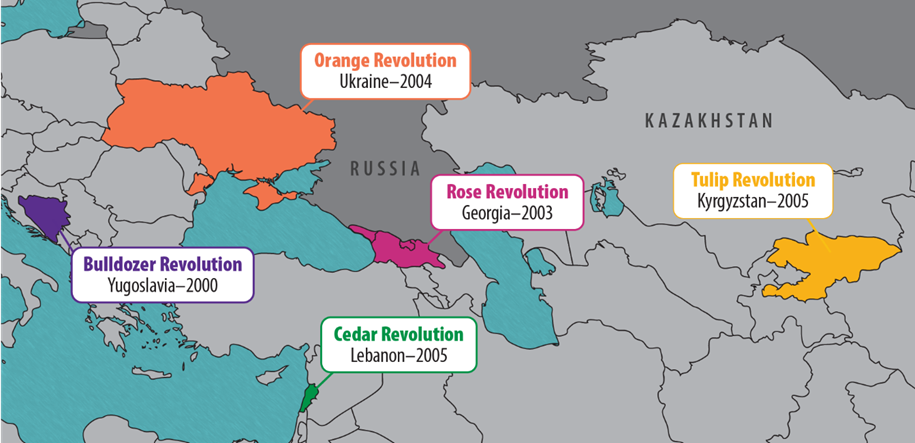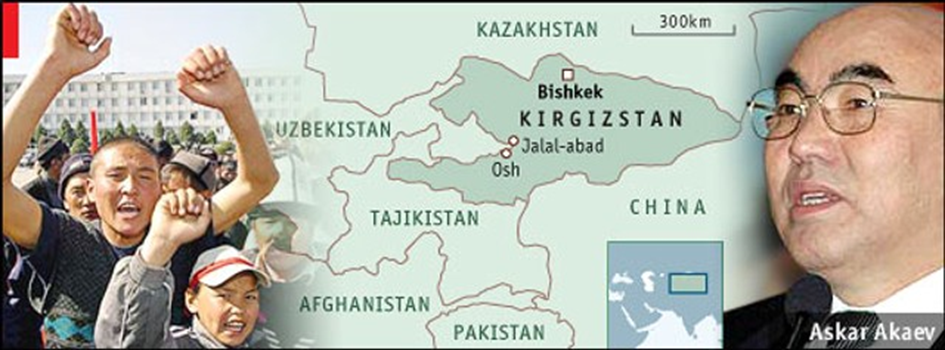Color revolutions are peaceful social movements against authoritarian regimes that took place in many countries, particularly in the former Soviet Union in the 2000s. These revolutions targeted regime changes by combining the people's demands for democracy and the search for free elections. These movements, often identified with a color or symbol, have been referred to as the Bulldozer Revolution in Serbia, the Rose Revolution in Georgia and the Orange Revolution in Ukraine. Color revolutions have left their mark on history through the impact of international support, popular reaction to electoral fraud and the role of symbolic power.

Regional “Color Revolutions” in Close Proximity to Russia (Source: Military Review)
International Context
Color revolutions refer to the mass movements of the 2000s, primarily in the post-Soviet region, that aimed to counter authoritarian regimes through peaceful means. These movements were significantly influenced by the international context of the time. Following the collapse of the Soviet Union in the 1990s, Russia was undergoing a prolonged period of economic and political recovery. The Western world sought to leverage this opportunity to expand democratic values and market economies. The United States and the European Union, in particular, increased their economic and civil society support in the region.
Meanwhile, Russia attempted to reassert its influence over its former Soviet territories. However, economic crises and political fragmentation limited Moscow’s ability to play an active role in these regions. This created an opening for Western-backed democratic movements to gain traction.
In countries closer to Western Europe, the European Union’s appeal accelerated democratization processes. Conversely, authoritarian regimes solidified their control in regions like Central Asia and Belarus. Nonetheless, by the early 2000s, unexpected democratic momentum emerged in countries like Serbia, Georgia, and Ukraine, often catalyzed by electoral fraud and popular dissatisfaction.
Revolutionary Processes
Czechoslovakia (1989 Velvet Revolution)
The Velvet Revolution of 1989 in Czechoslovakia is considered a key precursor to later color revolutions. This peaceful movement led to the fall of the authoritarian communist regime and a transition to a multiparty democracy. Spearheaded by student movements and labor unions, the revolution garnered widespread public support. Its defining feature was the "velvet-like" smooth and nonviolent nature of the transition.
Serbia (2000 Bulldozer Revolution)
The Bulldozer Revolution of 2000 in Serbia marked the beginning of modern color revolutions. Slobodan Milošević’s regime faced widespread opposition due to corruption and authoritarian practices. The student movement "Otpor!" (Resistance) played a pivotal role by employing creative and peaceful protest methods, leading to the regime's collapse. A symbolic bulldozer became the emblem of this revolution, which served as a model for subsequent movements.
Georgia (2003 Rose Revolution)
In Georgia, widespread electoral fraud during the 2003 elections sparked mass protests against Eduard Shevardnadze's administration. Under the leadership of Mikheil Saakashvili, the opposition forced Shevardnadze to resign. The Rose Revolution highlighted the critical role of civil society and international support in achieving democratic transitions.

Rose Revolution in Georgia, 2003 (Vano Shlamov/AFP)
Ukraine (2004 Orange Revolution)
The Orange Revolution in Ukraine began in response to significant irregularities in the 2004 presidential elections. Fraudulent victories for Viktor Yanukovych over Viktor Yushchenko led to widespread protests. Peaceful demonstrations and international pressure culminated in a rerun of the election, with Yushchenko emerging victorious. This revolution became one of the most iconic color revolution【1】
Kyrgyzstan (2005 Tulip Revolution)
The Tulip Revolution in Kyrgyzstan arose from public discontent over corruption and oppressive policies under Askar Akayev’s administration. The 2005 elections, marred by fraud, triggered mass protests, leading to Akayev’s ousting. However, post-revolution instability limited the long-term impact of this movement.

A photograph showing the Kyrgyzstan Revolution (Source: The Economist)
Uzbekistan (2005)
Although a revolution-like movement surfaced in Uzbekistan, it was forcefully suppressed by the government. The 2005 Andijan massacre marked a tragic end for pro-democracy activists, resulting in widespread disillusionment.
Common Characteristics of Color Revolutions
Color revolutions share several common features:
- Peaceful Protests: These movements were predominantly peaceful, motivated by electoral fraud and opposition to authoritarian regimes. This nonviolent approach garnered significant public and international support.
- Youth Movements: Student groups and youth-led movements were at the forefront, using technology and social media to mobilize large populations.
- International Support: Western nations, particularly the United States and the European Union, provided substantial resources, including financial aid, training programs, and media support, to bolster these revolutions.
- Response to Electoral Fraud: Most movements were reactions to fraudulent elections, creating a consensus around democratic principles and transparency.
- Symbolic Identity: Each revolution adopted unique symbols, such as roses in Georgia, orange colors in Ukraine, and tulips in Kyrgyzstan, to foster unity and global recognition.
US Support and Role
The United States played a critical role during the Color Revolutions, both directly and indirectly. This support can be analyzed under several main headings:
Civil Society and NGO Support
The US supported these revolutions through non-governmental organizations. Organizations such as the National Endowment for Democracy (NED), the International Republican Institute (IRI) and the Open Society Foundations provided financial and logistical assistance to local groups. These organizations were particularly active in election observation, democracy education and popular organizing. Assistance to protest groups in Georgia and Ukraine are concrete examples of this support.
The US accelerated the flow of information about the revolutions by supporting independent media outlets. For example, independent television channels and internet platforms in Georgia and Ukraine were financed with US funds. This enabled people to organize anti-regime protests more effectively. US support for the media increased the visibility of revolutionary movements and created national and international public opinion.
Education and Leadership Programs
The United States organized various programs to train young leaders involved in revolutionary movements. These programs provided young activists with information on methods of peaceful protest, developing strategies and gaining popular support. These programs have been particularly effective in training groups such as the “Otpor!” movement in Serbia. These methods were later applied in Georgia and Ukraine.
Diplomatic Pressure and International Support
The US used diplomatic channels to increase pressure on authoritarian leaders. In both Georgia and Ukraine, the US issued international statements condemning electoral irregularities, providing morale and international legitimacy to the opposition. It was also noteworthy that the US worked together with the European Union in this process.

US President George W. Bush with Mikhail Saakashvili in the central square of the Georgian capital Tbilisi in May 2005 (Source: STR/AFP)
Financial Resources
The US provided direct financial assistance during the Color Revolutions. These funds, which were specifically allocated to civil society projects, played an important role in meeting the logistical needs of the protests. For example, the stage, sound systems and other equipment used during the “Orange Revolution” in Ukraine were financed with this aid. According to Victoria Nuland, the US has allocated over 5 billion dollars to democracy projects in Ukraine since 1991.
Post-Revolution Period
Democratic Reforms and Limitations
In some countries, democratic reforms were implemented after the revolutions. For instance, in Georgia, Saakashvili's leadership made significant strides in reducing corruption and improving infrastructure projects. However, these reforms were often balanced by authoritarian practices. In Ukraine, while Yushchenko's era saw efforts toward democracy, economic challenges and political divisions limited the public's hopes.
Economic and Political Challenges
In the post-revolution period, most countries continued to face economic instability. In Kyrgyzstan, the post-revolution leadership struggled to address corruption and economic issues. This fell short of meeting the public's expectations for economic improvement promised by the revolutions.


